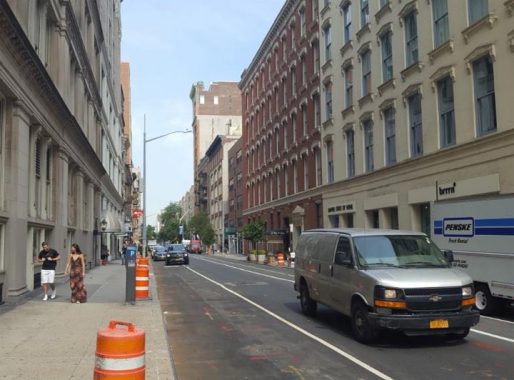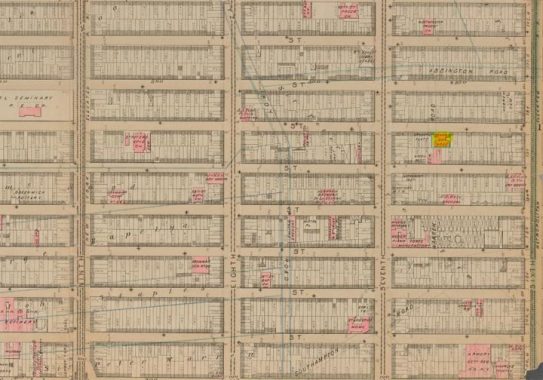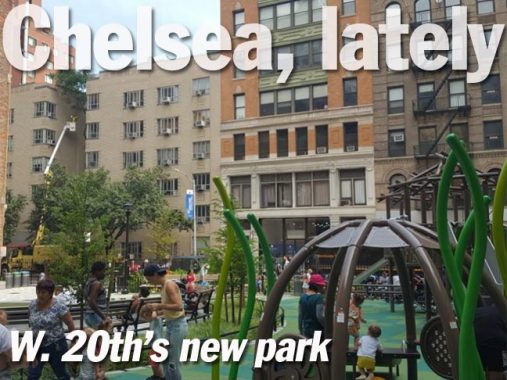By SERGEY KADINSKY
Forgotten NY correspondent
On July 25, 2019 the Manhattan neighborhood of Chelsea received its first new park in 40 years, with the opening of the .23-acre midblock green space titled Chelsea Green. It became an instant hit with local residents, highlighting the area’s transformation from commercial and manufacturing towards upscale residences.
Unlike many of Manhattan’s midblock parks, this one does not run between two streets. It has only one entrance, at 140 West 20th Street, between Sixth and Seventh Avenues. It is surrounded by century-old buildings that served as lofts and workshops, along with a tenement and former department stores.

Looking west on 20th Street from Sixth Avenue, one would not know that there is a park on this block, and the tourist crowds here are more likely headed to Kleinfeld Bridal, the wedding gown retailer that services more than 17,000 brides annually, with its own show, “Say Yes to the Dress.” They can follow it up with a toast across the street at Empire State of Wine. After the wedding, many couples discuss having children. On this block of lifetime milestones, that’s the role of Chelsea Green. Although the park is new, the land on which it lies has a long history of being the property of the public.

Looking at the 1879 G. W. Bromley map from the NYPL collection, three grammar schools appear on it, along with a few churches, breweries, dry goods shops, and a piano factory. A short walk to the west was General Theological Seminary, taking up its own block.

The site of Chelsea Green was Grammar School No. 55, which opened its doors on May 12, 1865 to serve the growing population of Chelsea. The most famous graduate of the school was photographer Alfred Stieglitz, who studied here from 1877 through 1879. With a talent towards mathematics and penmanship, he was hired by the principal as the school’s bookkeeper. One of his teachers then made a bet to have Stieglitz teach one math class, which he taught without any errors.
A closer look at the 1879 map shows two parallel blue lines skirting the edge of the grammar school. They represent a street, Warren Road that passed through the 300-acre farm of Sir Peter Warren, whose mansion stood at present-day Abingdon Square in Greenwich Village. Along with Warren Road, the pre-1811 map of Chelsea also included Southampton Road and FitzRoy Road, in honor of his son-in-law Charles FitzRoy, 1st Baron Southampton. Sir Peter was married to Susannah DeLancey, daughter of a prominent local family with its own street on the map. In turn, she was a descendant of the Schuylers and Van Cortlandts. All of this was before the American Revolution, although many noble names remain on the Greenwich Village map. Warren, FitzRoy, and Southampton Roads were decommissioned in the 1830s, eaten up by the Manhattan street grid.
The 1920 Bromley map shows the trace of Warren Road half covered by the garage at 148 W. 20th Street that is still in business today. Grammar School No. 55 is now used by the Department of Street Cleaning, the predecessor of DSNY. The rest of the block was filled with lofts, tenements, and factories.
By the time of the Great Depression the old school building was regarded as obsolete. It was replaced by a small office building with on-site parking. Perhaps not as fancy as the apartments on Grand Concourse and Miami Beach, but the Sanitation building had the defining Art Deco elements of striped brick lines, flagpoles engaged to the wall, and round porthole windows.
The design was nearly identical to six other DSNY offices from that decade: 427 East 87th Street, 7 North Moore Street, and 468 West 126th Street in Manhattan; In Brooklyn, there is 623 86th Street, and 766 Fifth Avenue, which lost its Art Deco elements after the city let it go private. In the Bronx, there’s 3323 White Plains Road which presently hosts a church.
The transformation of this site from Sanitation to Recreation goes back to September 2010 when Friends of 20th Street Park was formed by Matt Weiss and others, including Sally Greenspan and local artist Melissa Stern. Private funds were raised, political lobbying, participatory budgeting, and the support of Council Speaker Corey Johnson who represents this district, made this park happen.
A friendly attendant from the garage next door shared a rooftop photo of the park, showing the good fortune of the tenement residents next to the park. Their side windows were intended to provide air in a poorly lift air shaft. Instead they have views of Chelsea Green that will forever remain unobstructed. Likewise the residences and offices of the lofts on W. 19th Street whose back windows face the park.
Although the sanitation office is gone, there is another Art Deco contemporary across the street from the park, the Chelsea Warren apartments. Built in 1938 as a co-op, the name memorializes Warren Road on which it stands. Its architect Horace Ginsbern also built some Grand Concourse’s best-known apartment buildings.
The Chelsea Warren isn’t the only building on the block to remember Sir Peter Warren. In 2001, the corner of W. 20th Street and Seventh Avenue welcomed a new luxury apartment tower, The Westminster. Designed by star architect Robert A. M. Stern, its name honors Sir Peter’s role as the British Parliament member for Westminster from 1747 until his death in 1752.
I’d like to add that colonial Americans celebrated him not only for his marriage to a prominent New Yorker but also his commanding role in the 1745 capture of Louisbourg, which led to the explusion of the French from Nova Scotia. The striped bricks on the Westminster also hearken to the Art Deco style of Chelsea Warren across W. 20th Street. Stern’s residential towers have bricks and masonry, a classy look best exemplified by 15 Central Park West.
The park fills a void in a neighborhood with relatively little public green space. The nearest park to this one is Gertude B. Kelly Playground on W. 17th Street between 8th and 9th Avenues, which was also built on the site of a 19th century public school. In this City Council district, be sure to visit previous Forgotten-NY essays on two other post-millennial parks: the High Line, and Hudson Yards. On the eastern end of Chelsea Green’s block, there’s the Limelight: a landmarked church-turned-disco-turned-retail market. A block to the north, W. 21st Street is filled with historical architecture, and a small Jewish cemetery that is the only other green space in this area.
Chelsea Green is the most recent chapter for a site that had its start in transportation, then education, then sanitation, and now recreation!
Sergey Kadinsky is the author of Hidden Waters of New York City: A History and Guide to 101 Forgotten Lakes, Ponds, Creeks, and Streams in the Five Boroughs (2016, Countryman Press) and the webmaster of Hidden Waters Blog.
8/6/19
